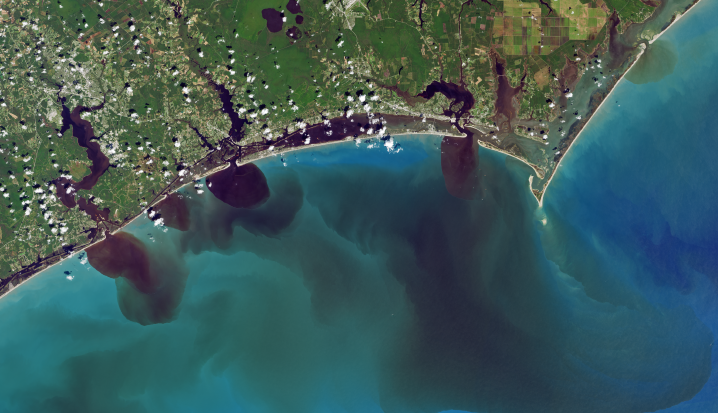Witnessing the environmental horrors of Hurricane Florence

This NASA Earth Observatory image shows polluted floodwaters from Hurricane Florence flowing into the Atlantic Ocean. (Image by Joshua Stevens, using Landsat data from the U.S. Geological Survey, from the NASA website.)
As Hurricane Florence's floodwaters began receding, environmental watchdogs affiliated with the Waterkeeper Alliance took to airplanes and boats to document the pollution released as a result of storm.
What they found is disturbing. The widespread, prolonged flooding brought by Florence — the second 500-year storm to hit the Carolinas in the past two years— took a heavy toll on southeastern North Carolina's industrial infrastructure and led to the release of massive quantities of pollution. NASA satellite imagery showed the state's discolored rivers pouring organic matter and pollution into the Atlantic.
The disaster-stricken region is a center of North Carolina's hog and poultry industries. The state currently permits hog farmers to store the animals' waste in massive, open-air cesspools known as "lagoons." The N.C. Department of Environmental Quality reports that at least 32 hog waste lagoons were inundated and another five experienced structural damage in the storm, sending waste into the floodwaters.
The Waterkeepers extensively documented the flood's impact on livestock operations and waste lagoons, taking numerous photos and videos. These are a few:


A hog farm pumps animal waste from a lagoon directly into Hurricane Florence's floodwaters. (Photo by Waterkeeper Alliance.)

Animal waste isn't the only significant pollution threat in Florence's floodwaters. North Carolina also currently permits coal-fired power plants to store toxic coal ash waste in wet pits and dry landfills next to the plants, which for cooling purposes are located along rivers and lakes.
Two coal plants owned by Duke Energy and their ash storage facilities flooded during Florence. At the shuttered H.F. Lee plant along the Neuse River near Goldsboro, a million gallons of toxic coal ash was completely submerged in the flooding and ash was described as "flowing like pudding." And at the still-active L.V. Sutton plant near Wilmington, a massive structural failure at a landfill sent coal ash spilling into the Cape Fear River. The Waterkeepers captured the aftermath of the flooding at the coal ash waste facilities:



Meanwhile, test results of Neuse River water samples released this week by the Waterkeeper Alliance found levels of arsenic near the site of the Lee coal ash spill nearly 18 times higher than the North Carolina standard for drinking water and fish consumption. The independent lab analysis also found elevated levels of lead and other heavy metals. Those findings contradict Duke Energy's, but the company took its samples some distance from the spill, as the Waterkeepers point out.
"Duke Energy continues to poison the Neuse River, while hiding behind water samples they collected six miles downstream from the inactive ash basins," said Neuse Riverkeeper Matthew Starr. "The levels of arsenic that Duke has dumped into the Neuse through its continued mismanagement of its coal ash are alarming, and every time that Duke misleads the public about the true impact of its coal ash, they put our environment and communities at risk."
Tags
Sue Sturgis
Sue is the former editorial director of Facing South and the Institute for Southern Studies.
